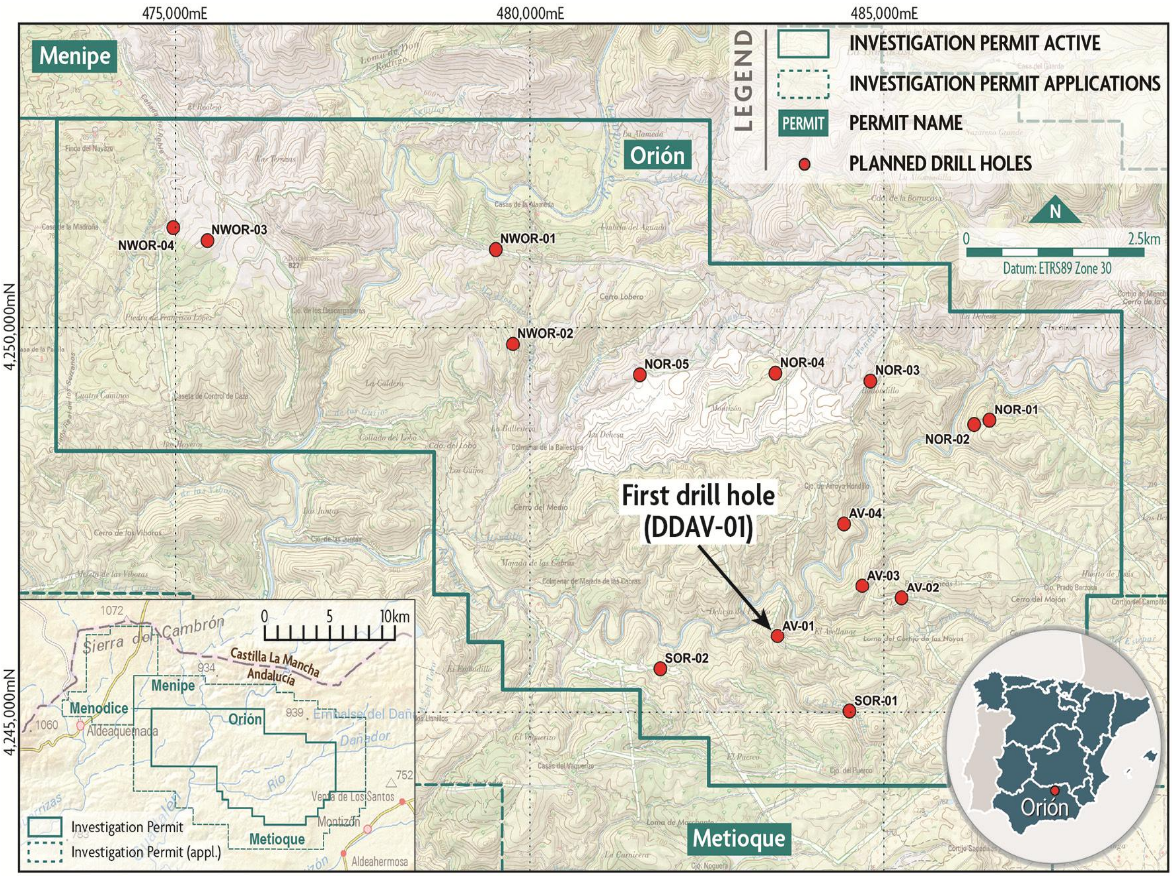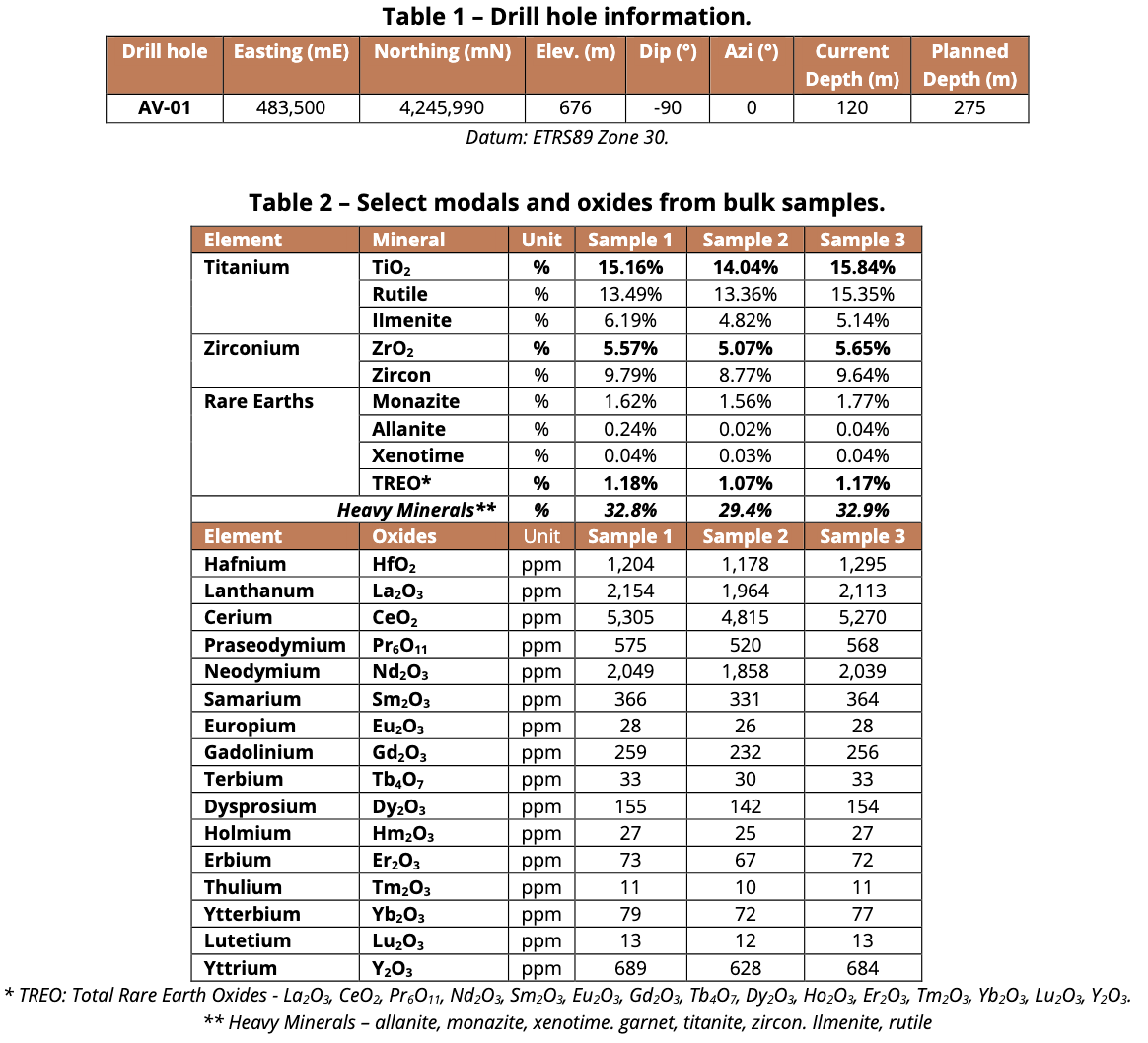First Drill Hole Intersects Targeted Prospective Stratigraphy
Osmond Resources Limited. ASX.OSM

HIGHLIGHTS
- First drill hole, AV01, has intersected the targeted prospective stratigraphy
- A 3.4m thick, highly prospective sequence has been fast tracked for assaying
- Company expects to confirm grade by end of October 2025
- Additional drill holes to commence with second rig in transit to Project
_________________
Osmond Resources Limited (ASX: OSM) (Osmond or the Company) is pleased to confirm the first hole (AV-01; Table 1) of its maiden drilling program at the Orión EU Critical Minerals Project (Orión or the Project) has intersected the targeted prospective stratigraphy, specifically the Ordovician Pochico Formation (Figure 1).

The Pochico Formation has been mapped throughout the Project area and is characterised by containing multiple layers enriched in heavy minerals. Within the Orión Investigation Permit, heavy mineral prospective layers have been mapped and sampled by Osmond across a minimum three (3) prospective zones and have been shown to be highly anomalous in the critical and strategic minerals rutile, zircon and monazite*. Heavy Mineral concentrations up to ~33% have been recorded by bulk channel sampling in Zone 1 (Table 2) (refer ASX release dated 6 September 2024).
Geological context
The Orión EU Critical Minerals Project is located in the Central Iberian Zone of the Iberian Massif. The Lower/Middle Ordovician sequence in the project area comprises three lithostratigraphic units from bottom to top: the Armorican Quartzite, the Pochico Formation, and Rio Black Slates.
The Armorican Quartzite is composed of white orthoquartzites in thick layers. It was deposited in a wide sandy shore basins supplied from continental sources and is considered a facies deposited in shallow seas on a passive continental margin†.
The Pochico Formation, which is up to 200m thick, and stratigraphically overlies the Armorican Quartzite, is composed of a multilayer of orthoquartzites, quartz sandstones, sandy shales, siltstones and mudstones. In the Orion Project area and surroundings, three members have been distinguished in the Pochico Formation‡:
- Lower Member (Pochico Layered Member): ~50m thick of a multilayer of tablet quartzite beds alternating with finer sediments showing wavy-bedding, horizontal lamination, wave ripple cross-lamination and locally low angle cross-stratification. The rest of organic activity is a characteristic in these layers with frequently Ichnofossils. The Lower Member of the Pochico Formation was deposited on a shallow siliciclastic shelf dominated by storms.
- Middle Member (Yellowish Pochico Sandstone Member): ~100m thick multilayers of sandstones, sandy mica-shales and siltstones, with wavy-bedding and locally hummocky cross-stratification. Several intercalations of massive dark quartzite layers appear among the multilayer, some of them enriched with heavy minerals, especially at the top half of the member. These layers show a roughly parallel lamination.
- Upper Member (Pochico Quartzite Intercalations Member): ~50m thick of black slates, mica-shales and several metric intervals of clear quartzite layers intercalated. The quartzite beds have low-angle cross lamination frequently.
The sedimentary structures and the trace fossil assemblage in the Pochico Formation indicate a lower shoreface to upper offshore marine environment, suggesting a progressive deepening of the sea level in a shallow-marine setting under relatively high sedimentation rates.
The Rio Black Slates are a homogeneous ensemble of slates with sporadic layers of sandstones with low-angle cross lamination and lenticular forms. There is a metric interval of siltstones with massive structure and lenticular bedding in the bottom part. The unit means the deepening of the offshore basin with fine sediments.
Drill hole AV-01
The first drill hole at Orión spudded in the top of Pochico Formation, in sandstones and slates of the Upper Member. Siliclastic lithologies were intersected that are identical to those sampled in near outcrops which contain heavy mineral enriched layers. The main prospective quartzite layer was intersected at a depth shown below (Table 3).
Samples have been collected from AV-01 over the entirety of the Pochico Formation and have been fast-tracked for assaying. Results are expected by the end of October 2025.
Osmond is continuing with its maiden 15-hole drilling program at Orión with a second rig due at the Project shortly.
Link to ASX Release: https://bit.ly/4nzTPRL
-Ends-
Media and Investor inquiries:
Anthony Hall | Managing Director and CEO
[email protected]
+61 417 466 039
Elvis Jurcevic | Investor Relations
[email protected]
+61 408 268 271
* Refer to Osmond Resources ASX announcements 6 September 2024, 28 January 2025 and 20 June 2025.
† Jensen, S. (2024). Sandstone mounds from the Ordovician of the Central Iberian Zone, Spain. Journal of Iberian Geology, vol. 50: 693-702.
‡ Rodríguez-Tovar et al. (2014). Lower/Middle Ordovician (Arenigian) shallow-marine trace fossils of the Pochico Formation, southern Spain: palaeoenvironmental and palaeogeographic implications at the Gondwanan and peri-Gondwanan realm. Journal of Iberian Geology, vol, 40(3), pp539-555.


